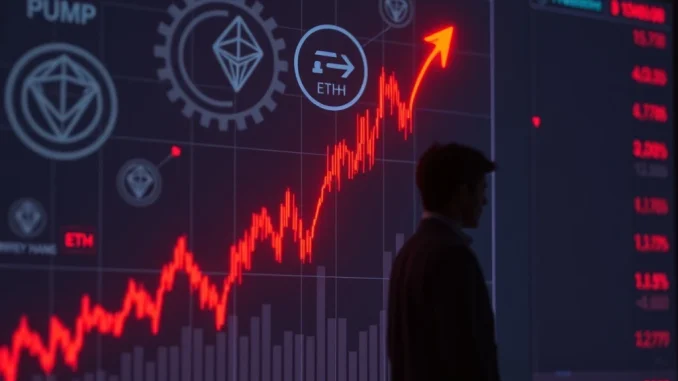
In the unpredictable world of cryptocurrency, where fortunes can be made or lost in the blink of an eye, one prominent figure has recently captured headlines for a high-stakes gamble gone awry. Jeffrey Huang, known in both the music and digital asset realms, has reportedly incurred a staggering $5.8 million crypto loss on a 5x leveraged position in the PUMP token. This incident serves as a stark reminder of the immense risks inherent in highly leveraged trading, especially in volatile markets.
Unpacking Jeffrey Huang’s High-Stakes Bet
Jeffrey Huang, a name synonymous with high-profile crypto investments, has once again drawn the market’s gaze. On-chain tracker Onchain Lens recently revealed his significant increase in a leveraged long position on PUMP token, a digital asset struggling to stay afloat, currently trading below its presale price of $0.004. His strategy involved a massive $12.12 million position, amplified by 5x leverage. Such a bold move has left many in the crypto community questioning the rationale behind such a high-risk play, especially given the current market uncertainties.
Huang’s decision to accumulate more PUMP tokens, despite an unrealized loss already hovering around $5.8 million, speaks volumes about his conviction in the asset’s future. It’s a testament to the high-stakes game that seasoned investors play, balancing potential exponential gains against the very real threat of substantial losses. This incident not only highlights the inherent volatility of the crypto market but also the amplified risks and rewards associated with leveraged trading.
The Perilous World of Crypto Leverage
Understanding the mechanics behind Jeffrey Huang’s trade is crucial to grasping the amplified stakes involved. Leverage in cryptocurrency trading allows an investor to control a larger position with a relatively small amount of their own capital. In Huang’s case, a 5x leverage means he controls a $12.12 million position with roughly one-fifth of that amount in actual capital, or margin.
While leverage can significantly magnify profits when the market moves in a trader’s favor, it equally amplifies losses. A small adverse price movement can quickly erode the initial margin, potentially leading to liquidation. Liquidation occurs when a trader’s margin balance falls below a certain threshold, triggering an automatic closure of the position by the exchange to prevent further losses. This mechanism is designed to protect both the trader and the exchange, but it can wipe out a trader’s capital in a flash.
Huang’s willingness to take such aggressive positions isn’t limited to PUMP token. He also holds a 25x leveraged long position on Ethereum (ETH) of undisclosed size, indicating a consistent strategy of betting big on long-term appreciation across multiple crypto assets, despite short-term market turbulence. This approach is characteristic of high-net-worth individuals who possess a significant capital base and a higher tolerance for risk compared to the average retail investor.
PUMP Token’s Struggle and Huang’s Conviction
The PUMP token’s current trading price, significantly below its presale value of $0.004, already signals challenges for early investors. Yet, Jeffrey Huang’s continued accumulation suggests a deeper conviction. Analysts have put forth several potential motivations behind this audacious strategy:
- Long-Term Vision: Huang might possess insider insights or a strong belief in PUMP token’s underlying project fundamentals, such as a robust development roadmap, upcoming partnerships, or a strong team, which he believes will eventually drive its value upwards. He may view the current price dip as a temporary setback rather than a terminal decline.
- Averaging Down: A common tactic among investors, averaging down involves buying more of an asset at a lower price to reduce the overall average cost per unit. While this can be effective if the asset eventually recovers, it also significantly increases exposure to a falling asset, amplifying risk if the price continues its downward trajectory.
- Market Influence: As a high-profile investor, Huang’s public moves can act as a signal to other traders, potentially inspiring confidence and driving a price recovery. However, such influence is not guaranteed and can backfire if broader market conditions remain unfavorable or if the project’s fundamentals fail to deliver.
The risks associated with PUMP token are substantial. Low-liquidity tokens like PUMP are particularly susceptible to sharp price swings, which can trigger rapid liquidations, especially when leverage is involved. Furthermore, if the project’s fundamentals do not improve—for instance, if development goals are unmet or community adoption remains weak—persistent selling pressure could undermine any recovery attempts, leading to further losses for investors.
Insights from On-Chain Data
The ability to track such high-stakes trades by prominent figures like Jeffrey Huang is largely thanks to the transparency offered by on-chain data platforms like Onchain Lens. These platforms provide an unprecedented level of insight into capital flows, whale movements, and overall market activity, democratizing information that was once exclusive to institutional players.
On-chain data allows anyone to see large transactions, wallet movements, and even the creation or dissolution of significant positions. This transparency offers several benefits:
- Market Understanding: By observing the actions of large holders (whales), market participants can gain a better understanding of potential trends, sentiment shifts, and accumulation/distribution phases.
- Risk Assessment: On-chain metrics can help identify potential areas of liquidity, concentration of assets, and even signs of distress in a project or a large holder’s portfolio.
- Due Diligence: While not financial advice, on-chain data can supplement fundamental and technical analysis, providing an additional layer of information for investors to consider before making decisions.
However, it’s crucial to remember that while on-chain data provides raw information, it does not offer financial advice. Interpreting the data requires expertise, and blindly following whale movements without conducting independent research into project fundamentals can lead to ill-informed and costly decisions.
Navigating the Crypto Loss Landscape: Lessons for Investors
Jeffrey Huang’s reported $5.8 million crypto loss serves as a powerful case study in the inherent duality of opportunity and peril within the crypto market. For retail traders, it underscores the critical importance of robust risk management strategies. While Huang operates with a capital base and risk tolerance far beyond typical investors—known for his extensive holdings in Bored Ape Yacht Club (BAYC) NFTs and other major cryptocurrencies—the lessons from his experience are universal:
- Strict Risk Management: Always employ strict stop-loss orders to limit potential downside. Never invest more than you can afford to lose. Understand position sizing relative to your overall portfolio.
- Understanding Leverage: If you choose to use leverage, fully comprehend its mechanics, including margin requirements, liquidation prices, and the amplified nature of both gains and losses. Start with lower leverage ratios until you are comfortable.
- Independent Research: Do not blindly follow the trades of high-profile investors or ‘whales.’ Their motivations, risk profiles, and access to information are often vastly different from yours. Conduct thorough due diligence on any project, examining its whitepaper, team, technology, community, and market viability.
- Market Volatility Awareness: Recognize that low-liquidity tokens and emerging projects are prone to extreme price swings. These assets can be highly speculative and may not offer the stability of more established cryptocurrencies.
- Diversification: While Huang’s portfolio includes diverse assets, retail investors should also consider diversifying their holdings to mitigate risk, rather than putting all their capital into a single, highly speculative asset.
The saga of Jeffrey Huang’s PUMP token bet is a vivid illustration of the high-stakes nature of cryptocurrency trading. It highlights the potential for massive gains but also the brutal reality of significant losses, especially when compounded by leverage. While on-chain data offers unprecedented transparency into these movements, it’s ultimately up to individual investors to exercise caution, conduct thorough research, and implement stringent risk management practices. In a market where volatility is the only constant, informed decision-making remains the most valuable asset.
Source: [1] [title] [url]
Add a public comment…PostNo yetDisclaimer: The news articles available on this platform are generated in whole or in part by artificial intelligence and may not have been reviewed or fact checked by human editors. While we make reasonable efforts to ensure the quality and accuracy of the content, we make no representations or warranties, express or implied, as to the truthfulness, reliability, completeness, or timeliness of any information provided. It is your sole responsibility to independently verify any facts, statements, or claims prior to acting upon them. Coin Pulse Fintech Inc expressly disclaims all liability for any loss, damage, or harm arising from the use of or reliance on AI-generated content, including but not limited to direct, indirect, incidental, or consequential damages.
Frequently Asked Questions (FAQs)
1. Who is Jeffrey Huang and why is his PUMP token bet significant?
Jeffrey Huang, also known as ‘Machi Big Brother,’ is a prominent figure in both the music industry and the cryptocurrency space, known for his large-scale investments and high-profile NFT holdings (like Bored Ape Yacht Club). His PUMP token bet is significant because it involves a substantial $12.12 million position with 5x leverage, leading to a reported $5.8 million unrealized loss. This highlights the extreme risks and potential outcomes of leveraged trading by influential crypto whales.
2. What does 5x leverage mean in cryptocurrency trading?
5x leverage means that for every $1 of your own capital (margin) you put in, you can control $5 worth of the asset. For example, to open a $12.12 million position, you would only need to commit approximately $2.42 million of your own funds. While this amplifies potential profits, it also magnifies losses, making a relatively small price drop capable of liquidating your entire margin capital.
3. What is the PUMP token and why is it considered a high-risk asset?
The PUMP token is a digital asset that, according to the article, is currently trading below its presale price of $0.004. New or low-liquidity tokens like PUMP are often considered high-risk due to their extreme price volatility, susceptibility to market manipulation, and potential for fundamental issues (e.g., unmet development goals, weak community adoption) that can lead to significant and sustained price declines.
4. How do on-chain data trackers like Onchain Lens work?
On-chain data trackers analyze publicly available information recorded on blockchain networks. Every transaction, wallet balance, and smart contract interaction is transparently recorded on the blockchain. Tools like Onchain Lens aggregate and interpret this data, allowing users to track large transfers, identify whale movements, monitor token distributions, and observe significant trading positions, providing insights into market activity and investor behavior.
5. What are the main risks associated with Jeffrey Huang’s strategy for typical investors?
For typical retail investors, the main risks associated with Jeffrey Huang’s highly leveraged, concentrated strategy include rapid liquidation of capital due to amplified losses, exposure to highly volatile and illiquid assets, and the potential for significant financial loss if the market moves unfavorably. Unlike Huang, most investors do not have the vast capital reserves or risk tolerance to withstand such substantial unrealized losses, making his approach largely unreproducible and extremely dangerous for the average trader.
6. What lessons can be learned from this incident regarding crypto loss?
This incident underscores the critical importance of rigorous risk management, including setting strict stop-loss orders and managing position sizes. It highlights the need for independent research into project fundamentals rather than blindly following high-profile investors. Furthermore, it serves as a stark reminder of the inherent volatility of the crypto market and the amplified dangers of using high leverage without a clear understanding of its implications.



